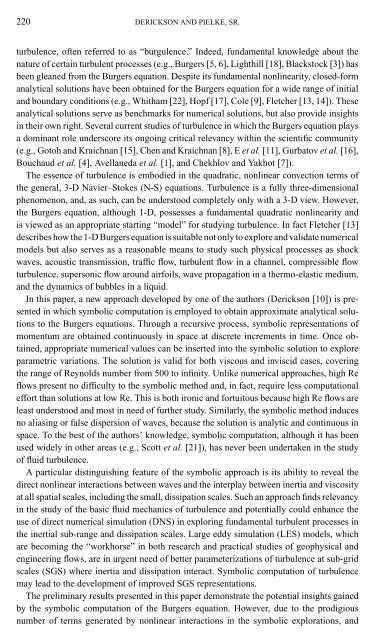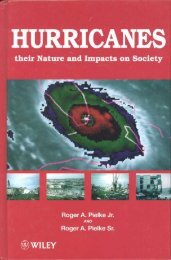A Preliminary Study of the Burgers Equation with Symbolic ...
A Preliminary Study of the Burgers Equation with Symbolic ...
A Preliminary Study of the Burgers Equation with Symbolic ...
Create successful ePaper yourself
Turn your PDF publications into a flip-book with our unique Google optimized e-Paper software.
220 DERICKSON AND PIELKE, SR.<br />
turbulence, <strong>of</strong>ten referred to as “burgulence.” Indeed, fundamental knowledge about <strong>the</strong><br />
nature <strong>of</strong> certain turbulent processes (e.g., <strong>Burgers</strong> [5, 6], Lighthill [18], Blackstock [3]) has<br />
been gleaned from <strong>the</strong> <strong>Burgers</strong> equation. Despite its fundamental nonlinearity, closed-form<br />
analytical solutions have been obtained for <strong>the</strong> <strong>Burgers</strong> equation for a wide range <strong>of</strong> initial<br />
and boundary conditions (e.g., Whitham [22], Hopf [17], Cole [9], Fletcher [13, 14]). These<br />
analytical solutions serve as benchmarks for numerical solutions, but also provide insights<br />
in <strong>the</strong>ir own right. Several current studies <strong>of</strong> turbulence in which <strong>the</strong> <strong>Burgers</strong> equation plays<br />
a dominant role underscore its ongoing critical relevancy <strong>with</strong>in <strong>the</strong> scientific community<br />
(e.g., Gotoh and Kraichnan [15], Chen and Kraichnan [8], E et al. [11], Gurbatov et al. [16],<br />
Bouchaud et al. [4], Avellaneda et al. [1], and Chekhlov and Yakhot [7]).<br />
The essence <strong>of</strong> turbulence is embodied in <strong>the</strong> quadratic, nonlinear convection terms <strong>of</strong><br />
<strong>the</strong> general, 3-D Navier–Stokes (N-S) equations. Turbulence is a fully three-dimensional<br />
phenomenon, and, as such, can be understood completely only <strong>with</strong> a 3-D view. However,<br />
<strong>the</strong> <strong>Burgers</strong> equation, although 1-D, possesses a fundamental quadratic nonlinearity and<br />
is viewed as an appropriate starting “model” for studying turbulence. In fact Fletcher [13]<br />
describes how <strong>the</strong> 1-D <strong>Burgers</strong> equation is suitable not only to explore and validate numerical<br />
models but also serves as a reasonable means to study such physical processes as shock<br />
waves, acoustic transmission, traffic flow, turbulent flow in a channel, compressible flow<br />
turbulence, supersonic flow around airfoils, wave propagation in a <strong>the</strong>rmo-elastic medium,<br />
and <strong>the</strong> dynamics <strong>of</strong> bubbles in a liquid.<br />
In this paper, a new approach developed by one <strong>of</strong> <strong>the</strong> authors (Derickson [10]) is presented<br />
in which symbolic computation is employed to obtain approximate analytical solutions<br />
to <strong>the</strong> <strong>Burgers</strong> equations. Through a recursive process, symbolic representations <strong>of</strong><br />
momentum are obtained continuously in space at discrete increments in time. Once obtained,<br />
appropriate numerical values can be inserted into <strong>the</strong> symbolic solution to explore<br />
parametric variations. The solution is valid for both viscous and inviscid cases, covering<br />
<strong>the</strong> range <strong>of</strong> Reynolds number from 500 to infinity. Unlike numerical approaches, high Re<br />
flows present no difficulty to <strong>the</strong> symbolic method and, in fact, require less computational<br />
effort than solutions at low Re. This is both ironic and fortuitous because high Re flows are<br />
least understood and most in need <strong>of</strong> fur<strong>the</strong>r study. Similarly, <strong>the</strong> symbolic method induces<br />
no aliasing or false dispersion <strong>of</strong> waves, because <strong>the</strong> solution is analytic and continuous in<br />
space. To <strong>the</strong> best <strong>of</strong> <strong>the</strong> authors’ knowledge, symbolic computation, although it has been<br />
used widely in o<strong>the</strong>r areas (e.g., Scott et al. [21]), has never been undertaken in <strong>the</strong> study<br />
<strong>of</strong> fluid turbulence.<br />
A particular distinguishing feature <strong>of</strong> <strong>the</strong> symbolic approach is its ability to reveal <strong>the</strong><br />
direct nonlinear interactions between waves and <strong>the</strong> interplay between inertia and viscosity<br />
at all spatial scales, including <strong>the</strong> small, dissipation scales. Such an approach finds relevancy<br />
in <strong>the</strong> study <strong>of</strong> <strong>the</strong> basic fluid mechanics <strong>of</strong> turbulence and potentially could enhance <strong>the</strong><br />
use <strong>of</strong> direct numerical simulation (DNS) in exploring fundamental turbulent processes in<br />
<strong>the</strong> inertial sub-range and dissipation scales. Large eddy simulation (LES) models, which<br />
are becoming <strong>the</strong> “workhorse” in both research and practical studies <strong>of</strong> geophysical and<br />
engineering flows, are in urgent need <strong>of</strong> better parameterizations <strong>of</strong> turbulence at sub-grid<br />
scales (SGS) where inertia and dissipation interact. <strong>Symbolic</strong> computation <strong>of</strong> turbulence<br />
may lead to <strong>the</strong> development <strong>of</strong> improved SGS representations.<br />
The preliminary results presented in this paper demonstrate <strong>the</strong> potential insights gained<br />
by <strong>the</strong> symbolic computation <strong>of</strong> <strong>the</strong> <strong>Burgers</strong> equation. However, due to <strong>the</strong> prodigious<br />
number <strong>of</strong> terms generated by nonlinear interactions in <strong>the</strong> symbolic explorations, and














